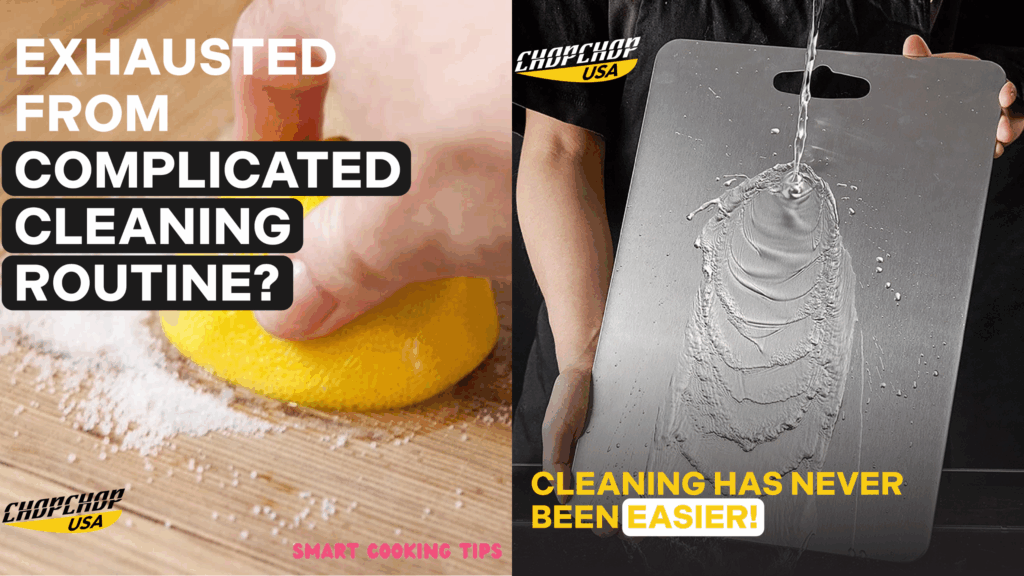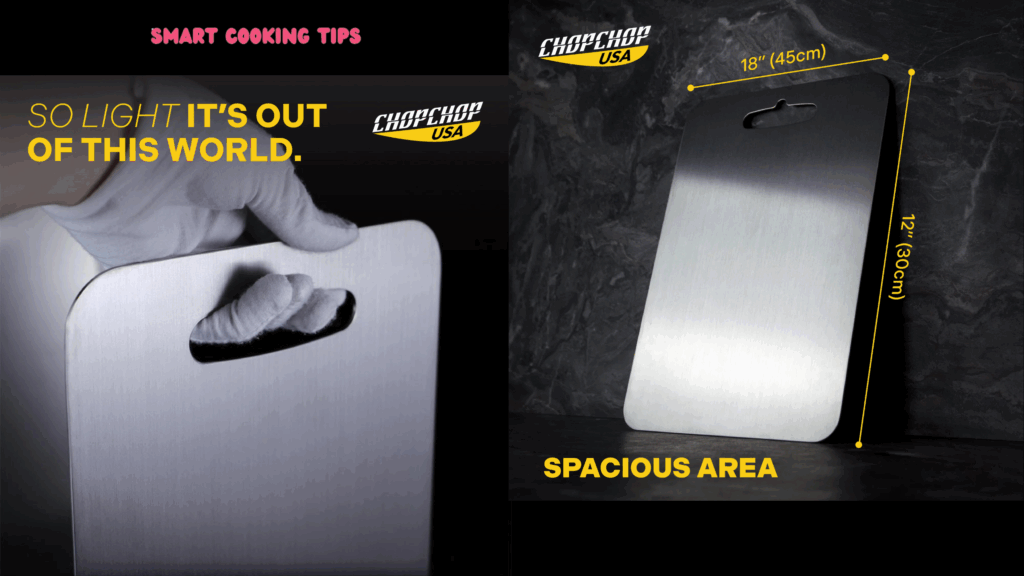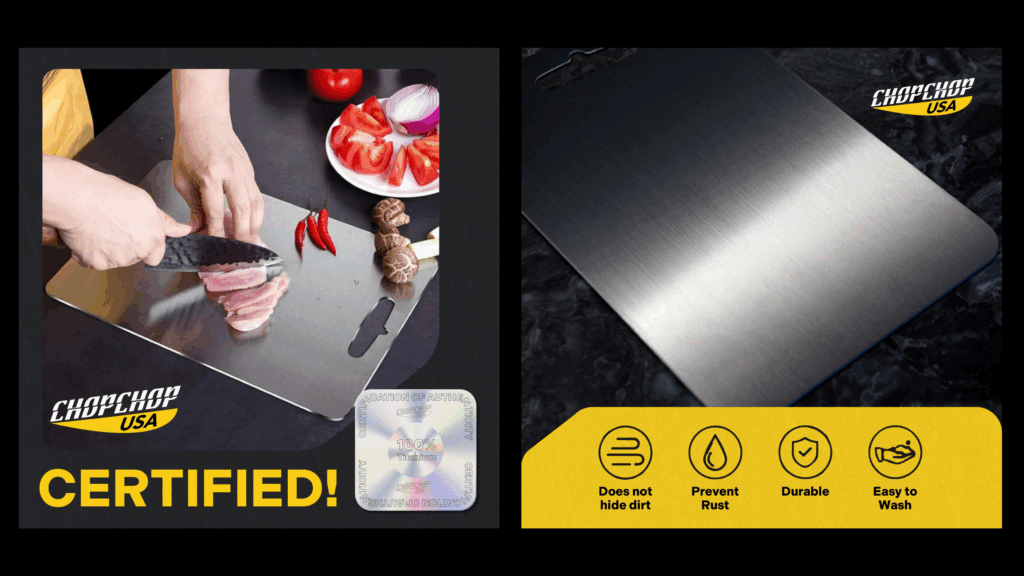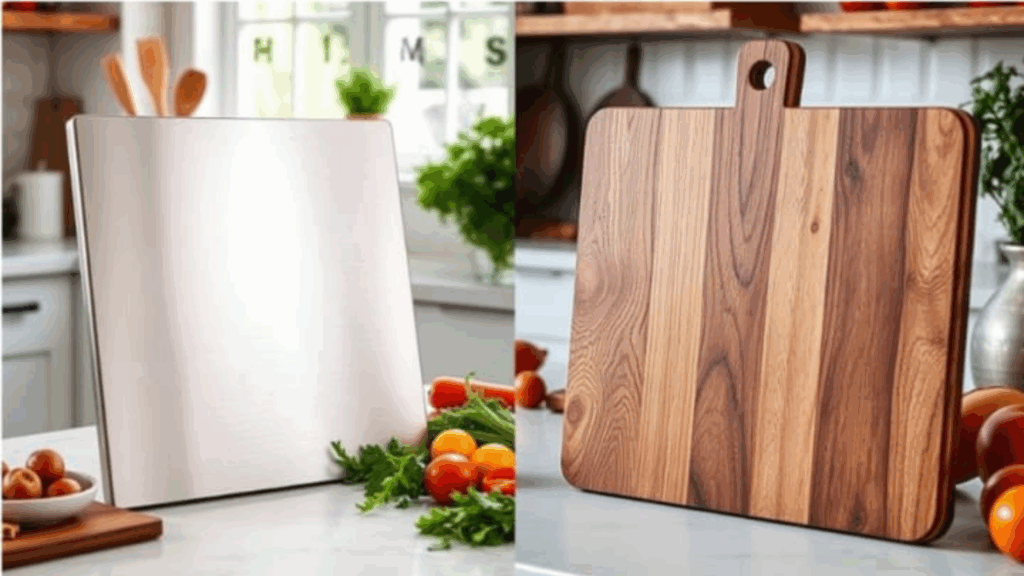In 2025, Titanium vs. Traditional Cutting Boards is a trending debate in the kitchen world. While traditional boards made of wood, plastic, or bamboo have been kitchen essentials for years, titanium cutting boards are gaining attention as a game-changing alternative. With their modern design and superior functionality, titanium boards are quickly becoming a must-have in many kitchens.
But which one is better for your kitchen? In this blog, we’ll compare the benefits and drawbacks of both materials, highlighting why titanium cutting boards are emerging as a superior choice in modern food preparation. Whether you’re upgrading your kitchen tools, searching for better hygiene, or simply curious, this comparison will help you make the right decision for your needs, offering insights into durability, maintenance, and overall performance.
1. What Are Traditional Cutting Boards?

Traditional cutting boards are typically made from materials like wood, plastic, or bamboo, and these have been kitchen staples for decades. Wood provides a sturdy surface and is gentle on knives, which helps maintain their sharpness. Plastic, on the other hand, is easy to clean and maintain, making it a practical choice for busy kitchens.
Bamboo has become a popular eco-friendly option due to its sustainability and fast growth rate. These materials have their merits and continue to be widely used in kitchens, offering durability, ease of use, and different benefits depending on personal preferences.
However, Titanium vs. Traditional Cutting Boards presents a shift in thinking. As technology and materials science continue to improve, alternatives like titanium cutting boards offer unique benefits that traditional boards simply can’t match.
2. Durability: Titanium vs. Traditional Cutting Boards
One of the main concerns with traditional cutting boards is durability. Wooden boards, for example, are prone to warping and cracking over time, especially when exposed to moisture. Plastic boards can develop deep grooves from knife cuts, which trap bacteria and make cleaning difficult. Bamboo, while durable, can also suffer from moisture damage and may splinter with prolonged use.
When it comes to Titanium vs. Traditional Cutting Boards, titanium is the clear winner in terms of longevity. Titanium is a highly durable metal that resists scratches, dents, and warping. Unlike wood or plastic, it won’t absorb liquids or odours, making it a more hygienic choice. The strength and resistance to wear ensure that titanium cutting boards last longer, making them a smart investment for those seeking a durable and low-maintenance option for their kitchen.
3. Hygiene: Why Titanium Wins

One of the most significant advantages of Titanium vs. Traditional Cutting Boards is hygiene. Traditional cutting boards, especially plastic and wood, can absorb juices from meats and vegetables, leading to bacterial growth in the grooves. Even after cleaning, these boards can still harbour germs, which may contaminate food.
Titanium cutting boards are non-porous, meaning they don’t absorb liquids or bacteria. This makes them much easier to sanitise and far more hygienic than traditional materials. With no grooves to trap food particles, titanium boards maintain a cleaner surface, offering improved food safety. If hygiene and food safety are a concern, titanium cutting boards are a true game-changer in the kitchen.
4. Knife Care: Which Material Is Easier on Your Blades?
When choosing a cutting board, you also need to consider how it will impact your knives. Titanium vs. Traditional Cutting Boards presents a significant difference in how each material affects blade sharpness.
Wooden cutting boards are generally gentle on knives, as they are softer than the metal of a blade. However, over time, even wood can wear down knives if not properly maintained. Plastic boards, while easy to clean, can be rougher on knives and cause them to dull faster.
Titanium cutting boards, on the other hand, are incredibly tough but are also designed to be knife-friendly. They won’t cause any damage to your blades, and unlike plastic, they won’t dull them over time. The cutting surface is resistant to scratching, providing a long-lasting, stable environment for your knives.
5. Environmental Impact: Titanium vs. Traditional Cutting Boards
Another aspect of the Titanium vs. Traditional Cutting Boards debate is their environmental footprint. Traditional cutting boards like bamboo are often marketed as eco-friendly, but this is not always the case. While bamboo is a sustainable material, the manufacturing process can be resource-intensive, and not all bamboo boards are treated with natural chemicals. As a result, some bamboo boards may not be as environmentally friendly as advertised.
Titanium, on the other hand, while not traditionally thought of as a “green” material, offers significant environmental benefits. Titanium is incredibly durable and can be recycled indefinitely without losing its integrity. This makes it a more sustainable choice over time, especially when compared to traditional boards that may need to be replaced more frequently due to wear and tear.
In terms of longevity, titanium cutting boards have a smaller environmental impact over time, as their durability reduces the need for constant replacements, ultimately making them a more sustainable option in the long run.
6. Maintenance: The Ease of Titanium vs. Traditional Cutting Boards
When it comes to maintenance, Titanium vs. Traditional Cutting Boards offers a clear advantage for titanium. Traditional cutting boards require regular upkeep to keep them in good shape. Wooden boards need to be oiled periodically to prevent them from drying out, while plastic boards can easily become stained and scratched. Bamboo boards, though eco-friendly, require care to avoid cracking, and they need to be kept dry to prevent mould growth.
In contrast, titanium cutting boards require minimal maintenance. They are virtually maintenance-free, needing only an occasional rinse and wipe down. Thanks to their non-porous surface, titanium boards resist staining and odour retention, making cleanup quick and effortless. With no need for special treatments or careful drying, titanium boards provide long-lasting durability with less hassle, offering a significant advantage in terms of convenience and ease of use over traditional options.
7. Weight: Titanium vs. Traditional Cutting Boards

Traditional cutting boards come in various weights depending on the material. Wooden boards tend to be heavier, offering stability, but can be cumbersome to move around. This added weight may be an advantage for stability, but it can make handling difficult, especially during long food prep sessions. Plastic boards are lightweight but can slip easily, causing frustration during cutting. Bamboo boards provide a balance between weight and stability but may not be as durable as wood or plastic alternatives.
Titanium cutting boards, however, are incredibly lightweight considering their durability. Despite their strength, titanium boards are often lighter than their wood or plastic counterparts, making them easy to handle and manoeuvre. This makes them a practical choice for busy kitchens, where convenience is key. Their lighter weight ensures effortless movement and efficiency during meal prep.
With titanium cutting boards, you can experience more comfort in the kitchen, and their added convenience makes them a popular choice for modern kitchens.
8. Cost: Is Titanium Worth the Investment?
While Titanium vs. Traditional Cutting Boards has many advantages, titanium boards often come at a higher price point. Traditional cutting boards, especially plastic or bamboo options, are generally more affordable, making them accessible for most households. However, given the durability, hygiene, and knife-friendliness of titanium, many find that the investment is worth it in the long run.
The cost of titanium boards is a reflection of their high-quality materials and construction. Titanium’s resistance to scratches, bacteria, and wear ensures a longer lifespan compared to traditional boards. When you factor in the longevity and reduced maintenance, a titanium cutting board can be a smart investment that pays off over time. For those who prioritise durability and hygiene, the upfront cost is justified by the long-term benefits it offers.
9. The Verdict: Titanium vs. Traditional Cutting Boards
So, which is better? The decision between Titanium vs. Traditional Cutting Boards ultimately depends on your personal needs and preferences. If you prioritise durability, hygiene, and knife care, titanium is the clear choice. Its resistance to scratches, bacteria, and wear makes it a superior option for those who want a long-lasting, hygienic cutting surface.
However, if you’re on a budget and prefer the aesthetics of a wooden or bamboo board, traditional cutting boards are still a reliable and affordable option. Their natural look and feel have kept them popular for years.
In 2025, many kitchens are making the switch to titanium due to its long-term benefits. Whether you’re looking for a cleaner, more sustainable cutting surface or just want a cutting board that will last for years to come, titanium offers an excellent alternative to traditional materials. It’s a small change that can make a big difference in your kitchen.
Final Thoughts

Titanium vs. Traditional Cutting Boards presents a decision that requires careful consideration. While traditional cutting boards have been reliable for years, titanium is quickly gaining popularity due to its superior durability, scratch resistance, and hygiene benefits.
CHOPCHOP USA titanium cutting boards are non-porous, meaning they won’t absorb odours or bacteria, making them easier to clean. Their sleek design and durability make them a smart choice for modern kitchens. Upgrade today with a CHOPCHOP USA and elevate your cooking experience.

